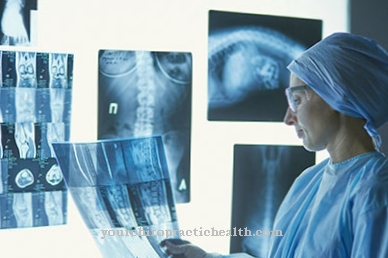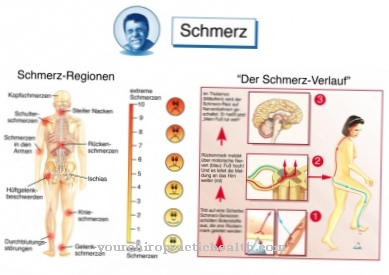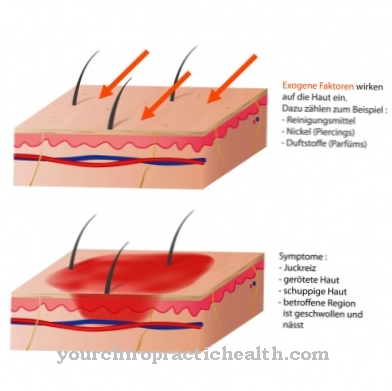A atrophy is a reduction in size of a tissue or organ. The cells in the affected area lose volume and mass. This can have both physiological and pathological causes.
What is atrophy?

© metamorworks - stock.adobe.com
Atrophy is tissue atrophy caused by a reduction in the number of cells in tissues and organs. This leads to a partial or complete reduction in size of the affected tissue or organ. This is made possible by apoptosis, i.e. programmed cell death.
The actual shape of the affected area can be retained or changed in the event of atrophy. Causes of atrophy can be poor nutrition, mutations, poor blood circulation, greatly reduced nerve supply, disuse of the muscles, or excessive cell death. Atrophy can be physiological, pathological, affect the entire system or be limited.
Physiologically, this occurs in the human growth process and enables the necessary changes in organisms. In contrast to pathological atrophy, this tissue atrophy is necessary and an important function of growth. To a certain extent, the pathological tissue reduction is reversible, that is, reversible to normal size.
causes
Atrophy has many different causes, which can be both physiological and pathological in nature. The pathological form arises from an imbalance between the building up and breaking down of the structure. Age atrophy has genetic causes and the moment of occurrence depends on the age of the patient and the disposition of the organs.
Some organs fulfilled their purpose early on and are broken down early on. This atrophy is called involution. After reaching sexual maturity, the thymus is atrophied and replaced by fatty tissue. The bone marrow also changes over the course of life. In childhood there is blood-forming parenchyma, i.e. red marrow, in the entire medullary cavity. With age, the red marrow atrophies in most places and is also replaced by adipose tissue.
The tissue shrinkage in the ovaries triggers menopause in women. The production of sperm in men is also reduced, but remains partially preserved. The starvation atrophy causes a reduction in general adipose tissue, skeletal and heart muscles and internal organs. In this case, the atrophy enables energy to be supplied while the food intake is greatly reduced. An unused muscle also atrophies, which is mostly the case in bedridden elderly patients.
This is known as inactivity atrophy. A strong reduction in the blood and nerve supply can also lead to the death of the cells after a long time and is called energy deficiency atrophy. Pressure atrophy is caused by chronic pressure on organs or bones. With increasing age, certain forms of atrophy can develop in the brain and cause diseases such as Parkinson's, dementia and Alzheimer's disease through structural breakdown.
You can find your medication here
➔ Medicines against muscle paralysisSymptoms, Signs & Ailments
The symptoms and symptoms of atrophy depend on the organ affected. Muscular atrophy is characterized by the reduction in size of one of the two extremities. This causes difficulty walking and maintaining balance. The affected area is light-headed, swollen, and tingling. The face is weakened and there is difficulty eating and speaking. The patient feels fatigue throughout the body.
In the worst case, the muscles are paralyzed. Atrophy of the ovaries introduces menopause. Initial symptoms of these are insomnia, cycle changes and mood swings. The estrogen hormones decrease and the stress hormones increase. Many women complain of a feeling of tightness and tension in their breasts just before their menstrual period.
Finally, there is no menstrual period. Organ atrophy leads to a loss or a reduction in the function of these. With optic atrophy, the optic nerve is severely damaged. This causes a decrease in eyesight or even blindness.
Diagnosis & course
Since atrophy can affect any tissue and organ, the diagnosis and the course of the disease are different. A reduction in the number and size of cells can be determined microscopically. To a certain extent, the atrophy is reversible.
Complications
In pathological atrophy, an imbalance occurs between the build-up and breakdown of cell structures, which leads to various complications and health disorders. This reduction in cell number and size can affect any organ in the body. The atrophy of the ovaries, which heralds the menopause with symptoms such as sleep disorders, feelings of tension in the breasts and mood swings, is uncomplicated until the menstrual period stops completely.
Men often suffer from testicular atrophy. Brain atrophy, on the other hand, is complicated and cannot be cured, but can only be slowed down through individual therapeutic approaches. As a result, dementia, Alzheimer's and Parkinson's can occur. In the worst case, muscle atrophy leads to movement and coordination difficulties.
The affected muscle areas show signs of paralysis and sensitivity disorders, it is difficult to eat and speak, and the patient feels signs of fatigue. Depending on the severity of the complications that occur, muscle atrophy can be treated with exercise therapy and medication that stimulates blood circulation. Age atrophy is a genetic breakdown of tissue that depends on the age and disposition of the patient's organs.
In growing people, some organ and cell structures have served their purpose prematurely. Therefore, premature atrophy occurs, known as involution. The broken down structures are replaced by fatty tissue. The bone marrow is also affected by this genetically determined process with increasing age. Since old age atrophy is a natural process, treatment is not necessary.
When should you go to the doctor?
If atrophy is suspected, you should speak to your family doctor as soon as possible. Depending on the type and severity of the atrophy, various warning signs point to a severe course. If you have difficulty walking and maintaining balance, you may have muscular atrophy. A doctor must be consulted immediately. The doctor can determine the atrophy on the basis of a microscopic examination and, if necessary, initiate treatment directly.
A doctor's visit is particularly urgent if swelling and pain are added to the symptoms mentioned or the affected area suddenly becomes numb or very sensitive to touch. At the latest, when there are difficulties eating and speaking as well as general signs of fatigue, you must see a doctor with muscle atrophy.
If you suspect ovarian atrophy, a visit to the gynecologist is advisable. Typical symptoms such as sleep disorders, mood swings and menstrual cramps should also be clarified independently of atrophy. Decreased eyesight or even blindness indicates optic atrophy, which must be treated immediately.
Doctors & therapists in your area
Treatment & Therapy
Not every atrophy can be treated. In some cases, this can only be slowed down, as in the case of brain atrophy. Depending on the form and cause of the atrophy, further tissue breakdown must be prevented and the metabolism stimulated. To prevent further muscle and joint loss, the affected area must be treated with physiotherapy.
Exercise therapy, positioning and cooling help here. In drug therapy, pain killers or blood-stimulating drugs can be used. Decreased blood flow is often the cause of atrophy. If orthostatic hypotension is the cause of reduced blood flow, support stockings and an increased water-salt intake can be effective.
Parkinson's disease can be treated with dopaminergics, which inhibit the breakdown of dopamine. In this case, the progression of the disease will be slowed down. A cure is not yet possible. Atrophy of hunger usually affects many parts of the body. In this case, lengthy therapy is imminent. The food intake must be increased and the metabolic balance restored.
Outlook & forecast
The prognosis for atrophy is individual and depends on the cause. Overall, however, they are considered less cheap. In the worst case, the progress of tissue shrinkage cannot be stopped with current medical possibilities.
It progresses relentlessly until the tissue is completely gone. This depends on the affected area and the damaged tissue. Consequences and further impairments in lifestyle occur.
In some forms of the disease, the goal of treatment is to delay the progress of tissue deterioration for as long as possible. At the same time, therapies with targeted training to maintain certain physical functions are offered. In drug treatment, side effects and additional symptoms of the disease are alleviated in a targeted manner in order to improve the quality of life of the person affected.
A cure or full recovery is not expected with atrophy. At present, according to the state of science and medicine, there are insufficient possibilities to cure the causes of the atrophy. If a therapy is generally rejected, the state of health gradually deteriorates.
Complaints increase and decrease the general well-being immensely. Often it is no longer possible to cope with everyday life without help. With medical care, the patient can be guaranteed an extension of life, since the breakdown process of the tissue is influenced.
You can find your medication here
➔ Medicines against muscle paralysisprevention
Genetically fixed atrophy cannot be prevented. In the physiological form, this is also not necessary. Pathological atrophy can be prevented through regular exercise, a healthy diet, and avoidance of toxic substances and hormones. Physiotherapeutic measures are essential for bedridden patients.In addition, a balanced diet enables a fair supply of energy to all organs.
Aftercare
Atrophy involves the shrinking of a tissue or organ. There is often no cure for this disease. The prognosis is unfavorable, especially with genetic causes. Follow-up care cannot therefore aim to prevent the disease from recurring. Rather, it is about supporting the patient in everyday life and eliminating complications.
It is important to slow down the progression. Doctors usually prescribe physiotherapy for this. They stimulate the metabolism and through suitable exercises inhibit the breakdown in certain body regions. However, depending on the cause, drugs can also prevent the disease from progressing. The ultimate goal is to stop tissue deterioration.
At an advanced stage, sick people often need help in everyday life. There is hardly any professional practice any more. Complications mainly occur when therapies are not used. Atrophy involves regular visits to the doctor. Patients can take action themselves to stop a non-genetic atrophy.
Preventive measures such as regular exercise and a varied diet are important. Alcohol and nicotine should be avoided. The body does not build up immunity after a single infection. A mostly hereditary disease is possible in different parts of the body.
You can do that yourself
Since atrophy can have many causes, including the lifestyle of the person affected or pathological causes, measures for self-help are only partially effective. So there are no noteworthy options that those affected by genetic atrophy can take. Even in the case of a very advanced atrophy in which a lot of tissue has already been lost, the measures are limited to slowing down the breakdown of the remaining tissue.
However, atrophy can often be slowed down or reversed if those affected adjust their diet. The nutrient supply must be increased significantly, whereby the metabolism must be activated in such a way that it works efficiently. So a balanced diet has to be put together, which at the same time brings more nutrients (and calories) with it than are needed.
Insufficient blood circulation can also lead to atrophy. This is where massages, exercise and avoiding substances that damage the blood vessels help. These include alcohol and trans fats. Light sport should be encouraged, whereby care should be taken to protect the joints and muscles. Little-used muscles and joints, which are particularly affected by the atrophy, should still be moved and massaged, which means that the person concerned has to continue physiotherapy measures themselves.




.jpg)
.jpg)






.jpg)



.jpg)










.jpg)
